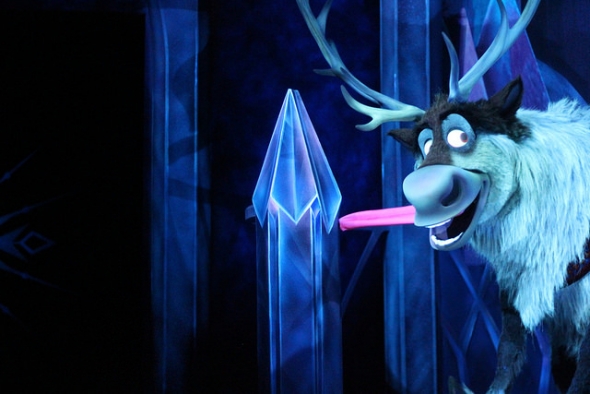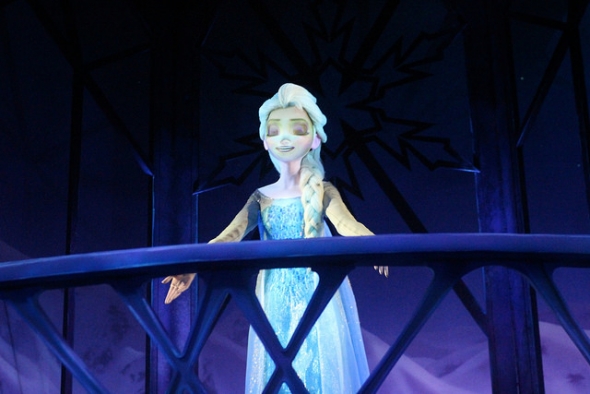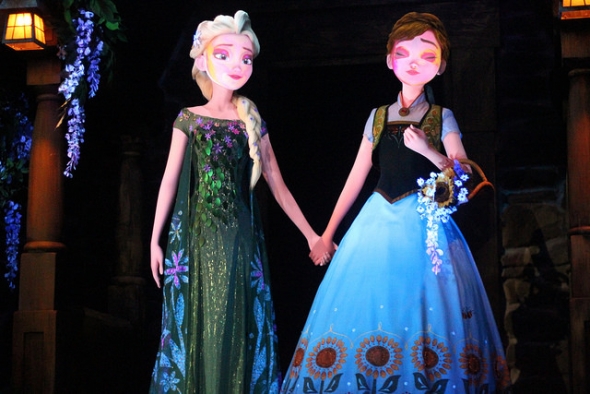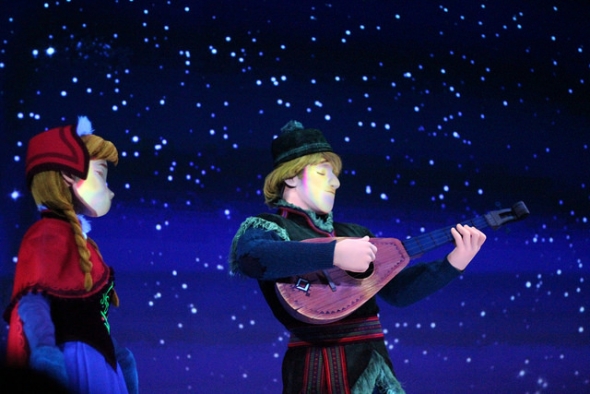Putting it all together...
Let’s circle back to Frozen Ever After to see how Disney handled the translation of their wildly popular movie into a new attraction. Knowing the audience is easy in this instance, given that it’s every fan of the film. Since Frozen has dominated Disney theme parks the last couple of years, ride planners already knew they had a hit. Still, they had to put themselves in the shoes of the guest, identifying which parts of the story are integral.
Correctly, Imagineers chose Let It Go as the seminal sequence. That’s why it functions as the high point of the ride, the center stage with the special spotlight. When Elsa sings, you’re on the edge of your seat, and that’s by design. It ably follows the rule of organized flow.
When Elsa finally embraces her powers, she feels a strange sense of liberation even as she isolates herself in the mountains. Frozen Ever After mimics this transition, eventually highlighting the seminal moment in the film when the ice queen breaks free from societal conventions.
As you watch Let It Go, the stage itself functions as a wienie. You enter the set moving forward and then leave by moving backward in your boat. The walls in and out of the scene all display versions of the same story. Elsa is singing Let It Go, and your eyes will see it everywhere. While the visual is stunning in and of itself, non-verbal communication exists in overt and subtle fashion. The overt way is through the power of Idina Menzel’s voice, conquering the room with her inimitable singing.
The subtlety stems from everything in the room that’s not Elsa. It’s dark save for her. Disney manipulates you to pay attention to what’s in front of you at the expense of everything else. You probably don’t even remember you’re on a boat until the doors shut, indicating that you’ve exited the showcase set. This is also a sign that Frozen Ever After has avoided overload. Less is more when Let It Go plays. Similarly, notice how crisp and fresh the other set pieces are on the attraction. The audio-animatronics (AAs) are the best ever, and so Disney lets them be the stars of the show. The sets are otherwise minimalist in tone, as the rider shouldn’t feel the distraction of looking away from the AAs.
Impressively, this minimalism also checks off the box for telling one story at a time. Each set piece stands on its own in isolation. Any fan of Frozen can easily recall the scene from the movie re-created for the attraction. Disney actually takes this premise one step farther by including characters from Frozen Fever at a memorable point in the ride. In this manner, they’re also checking off the final two maintenance boxes since the Frozen sequel will feature these characters. So, the ride is already updated to factor in a future film, and it resolves any lingering issues about the time period when Frozen Ever After exists.
As you can see, the only one of Disney’s storytelling rules that doesn’t apply to Frozen Ever After is providing a ton of treat for every ounce of treatment. It’s not an educational attraction per se although there’s a bit of thematic Norwegian building construction thrown in. So, the attraction clearly passes the test on nine out of ten rules of Disney storytelling. And if you want to make an argument about the treat/treatment one, I won’t fight you on the point. I’m sure Imagineers have thought of it in terms I couldn’t possibly understand.
The next time you visit a Disney theme park, take the time to consider how Disney tells each story. Apply the same test I’ve used for Frozen Ever After in the section above. Test how many of the rules above that you can see in action as well as which ones the company had to stretch a bit as a concession to maintaining the illusion. I would suggest a comparison of the oldest ride at the park followed by the newest. That way, you can see just how much the premise has evolved in the 60+ years since Walt Disney invented the theme park industry.





Comments
I think you misinterpret Commandment #8 (Avoid Contradictions – Maintain Identity), and I think this is a big problem overall with the addition of the 'Frozen' ride in Norway. World Showcase at Epcot tells stories of actual places with rich histories and cultures. By putting a fictional princess story in the mix, Disney has effectively contradicted that idea and risks losing the intended identity of this part of the park. I'm not saying there shouldn't be a "Frozen" ride - like most Disney fans, I love the film and totally appreciate the popular demand for an attraction related to that. What I'm saying is that they put it in the exact wrong place (Arendelle is a fantastical version of Norway; not actual Norway). Other attractions on World Showcase don't have this problem. Mexico has the "Three Caballeros" take us through Mexico, not an alternate version of that country. The United States takes us through U.S. history without relying on Pocahontas or Tiana to narrate. I think Disney broke its own rules, and I'm afraid it may lead to the demise of the story that Epcot's World Showcase was meant to tell.